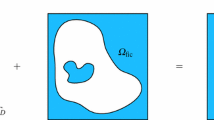Abstract
Constrained Delaunay tetrahedralizations (CDTs) are valuable for discretizing three-dimensional domains with constraints such as edges and polygons. But they are difficult to generate and maintain robustly when finite-precision coordinates yield vertices on a line that are not perfectly collinear and polygonal facets that are not perfectly flat. This work focuses on two key operations, polygon insertion and vertex insertion in CDTs. These operations suffice to incrementally construct and update a CDT from a Delaunay triangulation of the vertices. We experimentally compare two recent algorithms for inserting a polygon into a CDT: a bistellar flip algorithm of Shewchuk (Proc. 19th Annual Symposium on Computational Geometry, June 2003) and a cavity retriangulation algorithm of Si and Gärtner (Proc. Fourteenth International Meshing Roundtable, September 2005). We modify these algorithms to robustly succeed in practice for polygons whose vertices deviate from exact coplanarity. Vertex insertion in a CDT is much more complicated than in a Delaunay tetrahedralization. Adding a single vertex into a CDT may not yield a new CDT. Multiple vertices may need to be inserted together to ensure the existence of a CDT. We propose a new algorithm for vertex insertion. Given a new vertex to be inserted into a CDT, this algorithm adds one or more Steiner points incrementally. It guarantees a new CDT including that vertex.

















Similar content being viewed by others
References
Bowyer A (1981) Computing Dirichlet tessellations. Comput J 24(2):62–166
Chazelle B (1984) Convex partition of a polyhedra: a lower bound and worst-case optimal algorithm. SIAM J Comput 13(3):488–507
Cheng SW, Dey TK, Edelsbrunner H, Facello MA, Teng SH (2000) Sliver exudation. J Assoc Comput Mach 47(5):883–904
Cheng SW, Dey TK, Shewchuk JR (2012) Delaunay mesh generation. CRC Press, Boca Raton
Chew LP (1990) Building Voronoi diagrams for convex polygons in linear expected time. Tech Rep PCS-TR90-147. Department of Mathematics and Computer Science, Dartmouth College
Chew PL (1989) Guaranteed-quality triangular meshes. Tech Rep TR 89-983. Department of Computer Science, Cornell University
Clarkson KL, Shor PW (1989) Applications of random sampling in computational geometry, II. Discret Computat Geom 4(1):387–421
Devillers O, Pion S, Teillaud M (2001) Walking in a triangulation. In: Proceedings of the 17th Annual Symposium on Computational Geometry. Medford, Massachusetts, pp 106–114
Edelsbrunner H, Mücke EP (1990) Simulation of simplicity: a technique to cope with degenerate cases in geometric algorithms. ACM Trans Graph 9(1):66–104
Fortune S, Van Wyk CJ (1996) Static analysis yields efficient exact integer arithmetic for computational geometry. ACM Trans Graph 15(3):223–248
Guigue P, Devillers O (2003) Fast and robust triangle–triangle overlap test using orientation predicates. J Graph Tool 8(1):25–32
Hermeline F (1980) Une Methode Automatique de Maillage en Dimension n. Ph.D. thesis, Université Pierre et Marie Curie, Paris
Hermeline F (1982) Triangulation Automatique d’un Polyèdre en Dimension N. RAIRO Analyse Numérique 16(3):211–242
Lee DT, Lin AK (1986) Generalized Delaunay triangulations for planar graphs. Discret Comput Geom 1:201–217
Miller GL, Talmor D, Teng SH, Walkington NJ, Wang H (1996) Control volume meshes using sphere packing: generation, refinement and coarsening. In: Proceedings of the 5th International Meshing Roundtable. Pittsburgh, Pennsylvania, pp 47–61
Ruppert J (1995) A Delaunay refinement algorithm for quality 2-dimensional mesh generation. J Algorithms 18(3):548–585
Schönhardt E (1928) Über die Zerlegung von Dreieckspolyedern in Tetraeder. Mathematische Annalen 98:309–312
Schroeder WJ, Shephard MS (1988) Geometry-based fully automatical mesh generation and the Delaunay triangulation. Int J Numer Methods Eng 26(11):2503–2515
Seidel R (1982) Voronoi diagrams in higher dimensions (1982). Diplomarbeit, Institut für Informationsverarbeitung, Technische Universität Graz
Shewchuk JR (1997) Adaptive precision floating-point arithmetic and fast robust geometric predicates. Discret Comput Geom 18(3):305–363
Shewchuk JR (1998) A condition guaranteeing the existence of higher-dimensional constrained Delaunay triangulations. In: Proceedings of the 14th Annual Symposium on Computational Geometry, pp 76–85
Shewchuk JR (1998) Tetrahedral mesh generation by Delaunay refinement. In: Proceedings of the 14th Annual Symposium on Computational Geometry. Minneapolis, Minnesota, pp 86–95
Shewchuk JR (2000) Mesh generation for domains with small angles. In: Proceedings of the 16th Annual Symposium on Computational Geometry. Hong Kong, pp 1–10
Shewchuk JR (2000) Sweep algorithms for constructing higher-dimensional constrained Delaunay triangulations. In: Proceedings of the 16th Annual Symposium on Computational Geometry. Hong Kong, pp 350–359
Shewchuk JR (2002) Constrained Delaunay tetrahedralizations and provably good boundary recovery. In: Proceedings of the 11th International Meshing Roundtable. Ithaca, New York, pp 193–204
Shewchuk JR (2003) Updating and constructing constrained Delaunay and constrained regular triangulations by flips. In: Proceedings of the 19th Annual Symposium on Computational Geometry, pp 181–190
Shewchuk JR (2008) General-dimensional constrained Delaunay triangulations and constrained regular triangulations I: combinatorial properties. Discret Comput Geom 39(1–3):580–637
Si H (2008) Adaptive tetrahedral mesh generation by constrained Delaunay refinement. Int J Numer Methods Eng 75(7):856–880
Si H, Gärtner K (2005) Meshing piecewise linear complexes by constrained Delaunay tetrahedralizations. In: Hanks BW (ed) Proceedings of the 14th International Meshing Roundtable, pp 147–163
Si H, Gärtner K (2011) 3D boundary recovery by constrained Delaunay tetrahedralization. Int J Numer Methods Eng 85(11):1341–1364
Watson DF (1981) Computing the n-dimensional Delaunay tessellation with application to Voronoi polytopes. Comput J 24(2):167–172
Author information
Authors and Affiliations
Corresponding author
Rights and permissions
About this article
Cite this article
Si, H., Shewchuk, J.R. Incrementally constructing and updating constrained Delaunay tetrahedralizations with finite-precision coordinates. Engineering with Computers 30, 253–269 (2014). https://doi.org/10.1007/s00366-013-0331-0
Received:
Accepted:
Published:
Issue Date:
DOI: https://doi.org/10.1007/s00366-013-0331-0




